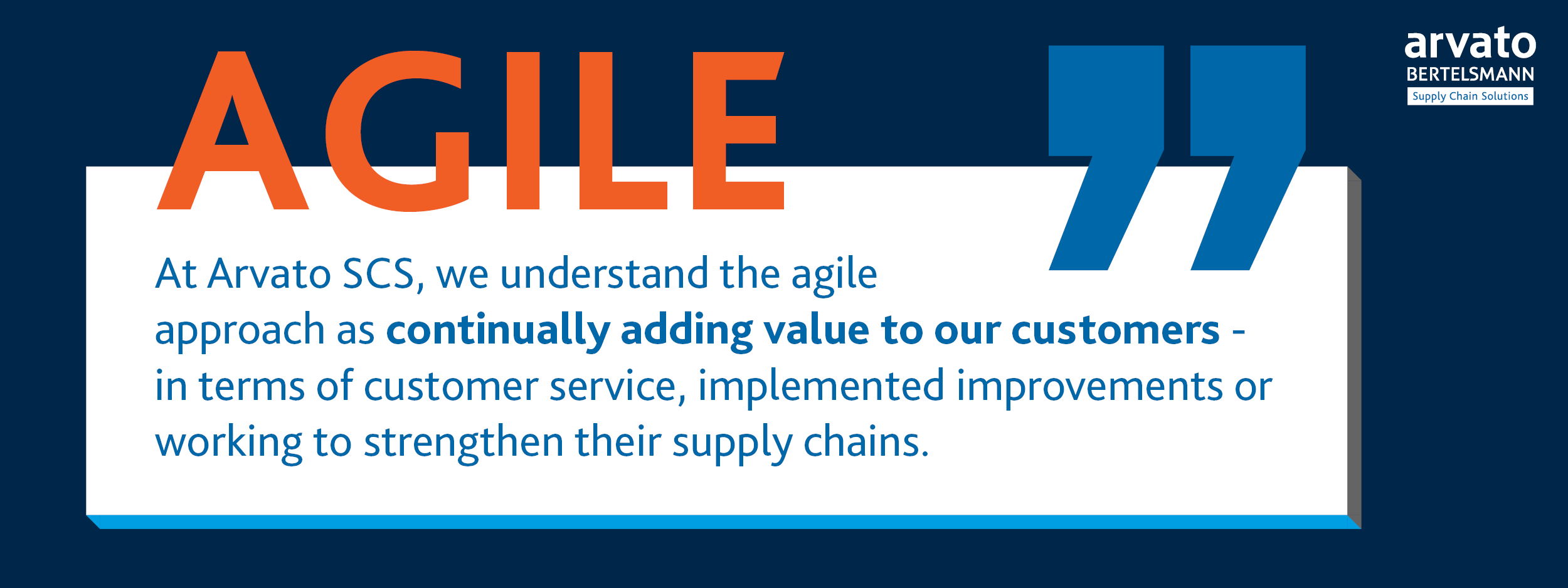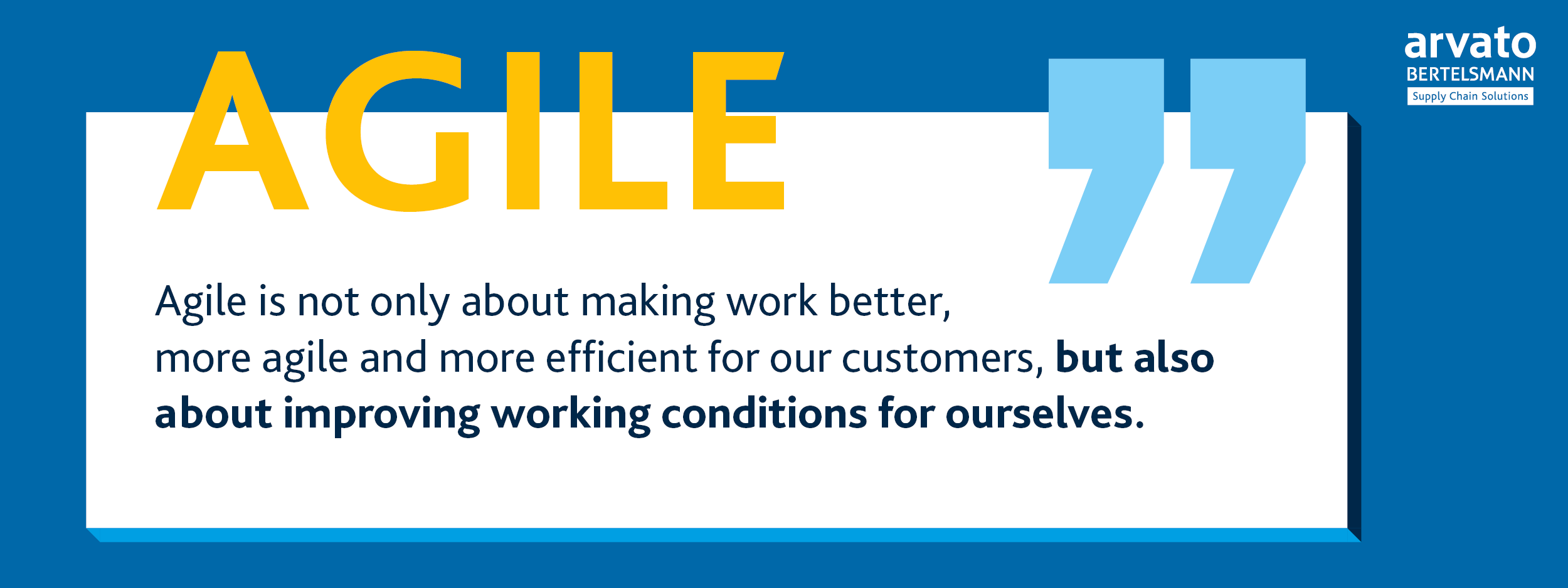Lean management and agile management are the answer to the need for improvements in process performance management and the implementation of changes in processes. Each approach focuses on a different aspect. While lean management focuses on reducing costs by improving process efficiency and reducing waste, agile goes further – moving towards flexibility and focus that gives the best possible response to the customer’s current needs. How to implement and use agile in logistics?

The agile approach employed in logistics is often known simply as “agile logistics”. So what does “agile” actually mean in this case? It means that you have to act quickly, efficiently and in real time. And everyone must know what their tasks are, be responsible for them and realize the importance of their work for the whole process. Finally, in agile logistics, warehousing, picking and forwarding solutions are integrated with data collection, processing and customer service.
Agile in logistics is also more than that. It’s about working according to values, respecting employees (not human resources), trusting the employees and believing that it’s important to keep getting better, continuously learning from experience and mistakes by correcting them and optimising performance. At Arvato SCS, we understand the agile approach as continually adding value to our customers – in terms of customer service, implemented improvements or working to strengthen their supply chains.
How to implement Agile in logistics?
The agile methodology is not simple. It requires a lot of preparation, cooperation of interdisciplinary teams, and, above all, understanding of the changes being introduced. Its application is the result of many consultations, workshops, as well as a test of managerial competences for team leaders. I believe that the introduction of agile is, however, first and foremost a change in the way of thinking and the attitude towards fulfilling one’s responsibilities. And that’s why it should be implemented in a steady, multi-stage process, area by area, to really bring about improvements rather than chaos. Implementing the agile methodology requires, above all, good planning and communication.
Start with an analysis
The beginning of the work is a time for audits and analyses, looking at how to improve the effectiveness of what is already in place. We should start with strategic areas, and then extend the analysis to other areas. After drawing and reporting conclusions, we need to focus on prioritizing the work but, above all, on creating an agile strategy in the company. At Arvato SCS we called it the ‘Agile Mindset’ and defined its main pillars, which were: cross-functional collaboration, product development, product and ownership thinking and building a strong data-driven company. We assumed that the approach would lead to a new quality of customer service, increased efficiency and even better collaboration within and between teams.
We should also remember that at this stage of the work it is worth focusing on analysing the internal needs of the organisation itself. Maybe we want to improve the induction of new employees into their tasks? Maybe change the incentive system or the whole work culture? Agile is not only about making work better, more agile and more efficient for our customers, but also about improving working conditions for ourselves.

Get the knowledge
Once the goals are set, written down and communicated to all those involved in the process, it’s a good idea to plan a series of workshops and training sessions. These can be led first by an external agile and scrum expert, and then by internal trainers (coaches). It is very important that not all the work happens at the same time, because there is a risk that the project will grow to a large size, involving too many people who, having to take care of their current duties, will either not engage properly in the new mindset, or regrettably fail to complete their daily tasks.
Training should start with a detailed explanation of the methodology and ways of working on its implementation and answering all questions of the project participants. Understanding the objectives, but, above all, the principles of work will allow to successfully complete the entire transformation.
Create teams and appoint leaders
Training and workshops – apart from clarifying concepts and gaining knowledge – will also allow for the emergence of natural project leaders, as well as an understanding of the roles of each participant. A good observation of the engagement will make it easier for managers to identify product owners, who will be responsible for the development of strategic products during further work, and scrum masters, who will be responsible in teams for the effectiveness of the implementation of changes and the framework.
It is under their auspices that teams should be established and given responsibility. What is key is that these teams must have not only strictly defined areas of activity, but also timelines, taking into account, for example, the implementation of both the “quick” goals (those implemented in the short term) and those whose achievement will take a year or two. Of course, in the agile methodology you don’t create detailed schedules or deadlines for selected tasks or jobs, but the framework approach is essential. Responsible time management is a rule which needs to be reminded to those whose project is growing over time. Remember also that it is easier to come up with a solution to a problem than to implement it, so the distribution of tasks over time, among teams, and among leaders is of key importance for the agile approach.
At Arvato SCS, we have set up an Agile Change Team – a kind of agile team for which internal recruitment has taken place. It works closely with the team consulting on individual activities.
Team members are energetic, committed and self-motivated
In teams, there is no lead person who distributes tasks – members themselves decide which activities have the highest priority at a given time or on a given day. The most important thing is the mindset of the team, changing from a task-based to a product-based approach.
Remember that the interdisciplinary nature of each team means that it is mostly impossible to plan work in such a way that every team member has a task in line with the sprint goal. The multi-product nature of the sprint means that the team often switches between products, or works on them in parallel, making it impossible to achieve a full team focus on the sprint goal. These situations may cause some team members to feel chaotic and eventually lose focus on the goals.
Build accountability
The Agile methodology drives accountability. Not just for your part of the job, but for the whole job or product and for the final result. At Arvato, thanks to the agile methodology, we are changing the attitude of the customer service staff (KAMs) persuading them that working with the customer is actually taking care of the product on a daily basis. We are also creating Product Manager jobs for strategic products for which a dedicated team is needed. Such persons focus only on the product, while product owners often have additional tasks such as, for instance, to manage a department or another process.

With the customer in mind
The customer value chain involves a close collaboration in such areas as innovation, R&D and customer service. All to ensure that our customers receive the best possible service.
Every consultant and every employee in the agile methodology should know what their role is for a given client, how important it is for the whole work and process and what they do well, but also what they could do better. This approach means that we no longer work on “tickets” or individual tasks, but on larger parts of the whole process. Only then can we build value for the whole organisation, a sense of shared responsibility, collaborative teams and good communication.
The implementation of Agile in our company has not only resulted in more and more bottom-up improvements and initiatives from the respective teams, but above all made people in different areas notice the needs and start describing their products and asking the central agile team for support. Our goal is to spread the ownership approach so that every person in every department can think about the product they are developing and so that we can define the right product owner for that product. Then, if there is a need for the support from a cross-functional, strategic and interdisciplinary team, the product owner can describe their product in detail on a special template, define the need for a dedicated team, the objectives of its creation and ultimately make the “agile” work begin. One year on from the launch of the agile methodology, our Digital Team has implemented, among other things, a new system for automatic sizing of products in the warehouse and a system for new, more optimised picking paths. Additionally, the Arvato Data Team – the second team – has implemented a dashboard for customers, where they can easily view the current status of order completion and how picking performance is achieved.
Agile in logistics is not limited to an agile approach to work. It is above all a positive approach, focused not on the problem, but on finding a solution. With this methodology, we concentrate on learning, improving and streamlining our work rather than on some distant goals. We sometimes find smaller solutions, but they are implemented faster. Agile in logistics projects helps in day-to-day work, especially when there are peaks, unforeseen situations and when you have to react flexibly to the current situation. It ensures an individual approach to each of our customers and, of course, the highest quality of customer service.

 30 maja 2022
30 maja 2022  Krystian Brydzki
Krystian Brydzki
 Arvato
Arvato
